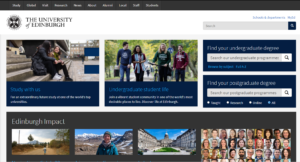A case study of the homepage: 13 tonnes of carbon saved through sustainable web design choices.
Working alongside the Digital Marketing Team, we have managed to reduce the page weight of the University’s homepage, www.ed.ac.uk, so that it produces 13 less tonnes of CO2 per year.
Implementing the change
As part of the wider EdWeb2 update, the university’s homepage has undergone changes to improve its performance and reduce its environmental impact.
Basically, we have optimised image sizes to reduce energy usage. Over the 65,539 pages on EdWeb2, we have estimated this change has reduced 25 tonnes of CO2 yearly.
To read more about this EdWeb2 update, read my other blog explaining the impact:
The impact of the homepage
Out of these 25 tonnes, 13 of them come from the homepage.
That’s 52% of the savings – From 1 page out of 65,539!!
Homepages have always been a key area to address. Not only do they receive the most traffic, but they also often hold the most data due to their need to be a one stop shop for all requests. Therefore, even small web design changes can have a massive impact on carbon reduction.
If you don’t know where to start when it comes to sustainable web design, start at the homepage – or the start of user journeys. As these gain the most traffic, they will result in ‘quick wins’.
Progress over the year
Using the web sustainability tool, digital beacon, we have been able to track the progress of the homepage, www.ed.ac.uk, across the past year.
Digital Beacon – Web Sustainability Tool
This is a screenshot taken from their tool with a record of 12 previous crawls over the last year:

A record of the previous web sustainability crawls of the University of Edinburgh’s homepage
Since 27th June 2024, the page weight of the homepage has decreased by 85% from 7.14Mb to 1.06 Mb (with the most recent crawl at the top of the table).
Annually, this is estimated to represent a decrease from 15.2 annual tonnes/CO2 to 2.3 annual tonnes/CO2 produced.
Now I can’t pretend to take credit for this, as it was fully down to the work and decisions of both the EdWeb2 team and the owners of this site, the Digital Marketing Team.
Positive change is always a team effort – and it’s great to see this work has helped us move towards a smaller, greener web estate.
Here’s a bit about the work that the digital marketing team has done to support and initiate this change:
“A timely intervention from Osh in Website and Communications was a useful reminder that sometimes your standard processes and best practice can slip.
We all know about image sizes, file types and compression but over time we’d become complacent and PNG images had crept in as the default image type on the homepage.
When Osh highlighted the weight of the homepage it was a shock and then a worry. Had the EdWeb2 migration seriously inflated the code base, were image dimensions seriously wrong? Thankfully it was none of those things, a quick investigation highlighted that by simply choosing PNGs over the more efficient JPG file format, we had unsuspectingly increased the page size and unfortunately the carbon footprint had ballooned.
With a few simple image updates and a refresher on our content workflows, we were back on track.
And remember, an efficient website isn’t just about saving carbon. Users expect fast and responsive websites, and page load and render speed are performance metrics that can influence your SEO ranking.
Pay attention to the small details and you can have a big impact.”
– Steven Ross, Head of Digital Marketing
Does sustainable mean sacrifice?
When you start talking about sustainable web design, suggestions such as removing animations or reducing the definition of images can arise. This can, quite rightly, set off alarm bells for marketers and designers alike.
But for me, sustainable web is more so about care and intelligence in design, rather than passively looking to remove data. Sure, a webpage with no media, and pure text would seem like a good thing for the environment, but when it isn’t engaging or doesn’t meet the user’s needs, it isn’t good for anyone.
The lowww directory showcases how sustainable web design is not about going backwards, but designing with intention. The directory shows off loads of examples of bright, flashy, modern webpages that are all incredibly low carbon. It has examples of pages with super-optimised, crisp images, light weight animations and even low carbon video embeds.
Lowww.directory – Low carbon designs
Quality or style don’t need to be sacrificed for sustainability.
By using the wayback machine, I have been able to get a screenshot of the university’s homepage from both the 27th June 2024, when it weighed 7.14Mb, and the 11th June 2025, when it weighed 1.06Mb.
Can you guess which is which?


One of these webpages uses 7 times more energy than the other one – but it’s pretty impossible to tell.
Sustainable web design improves your websites relationship primarily with the environment but also your users. It improves your page load speeds, accessibility for users across the world and reduces energy costs. A bit of a no-brainer.
For a comprehensive guide on sustainable web design see:

